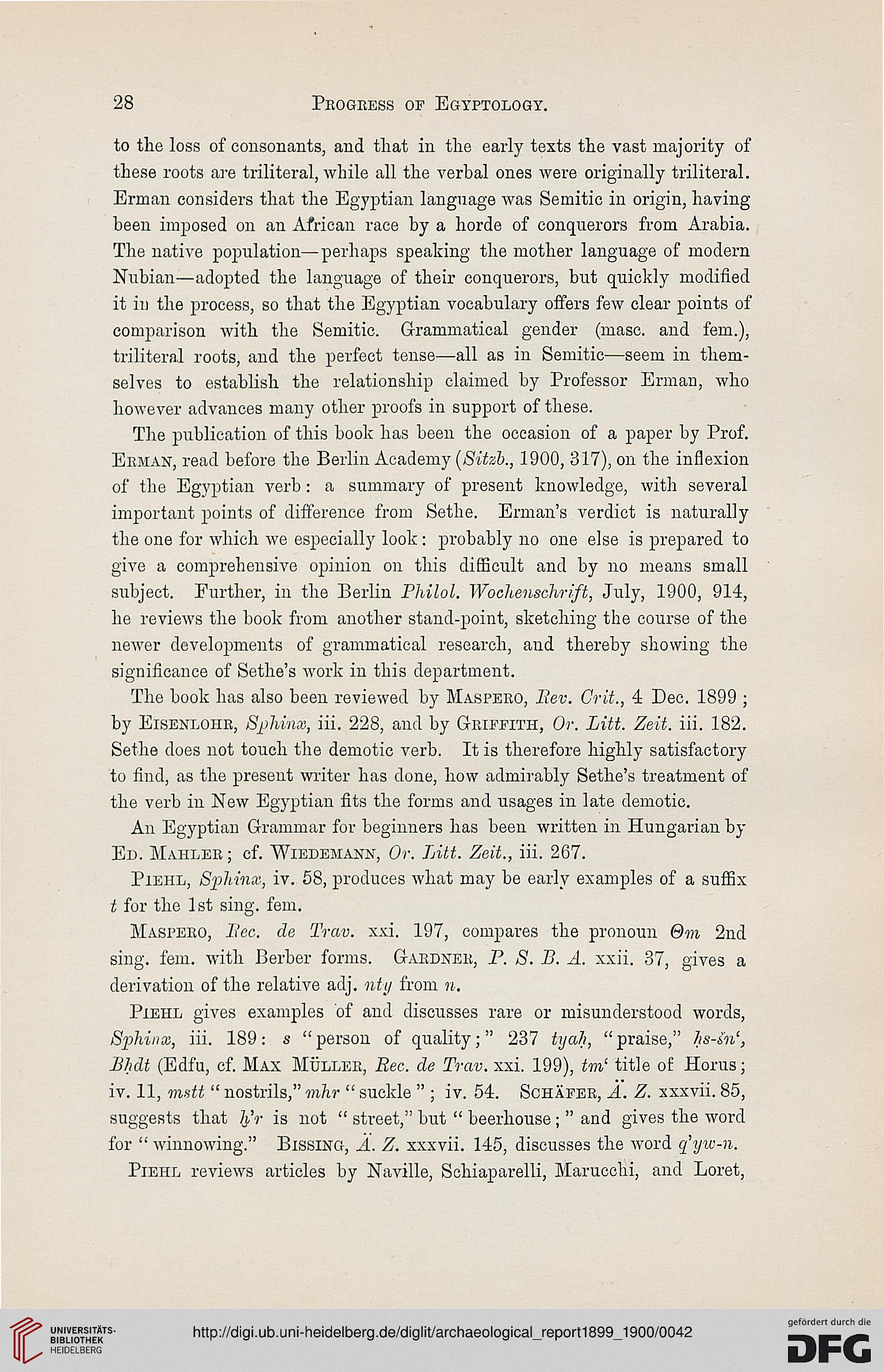28
Progress of Egyptology.
to the loss of consonants, and that in the early texts the vast majority of
these roots are triliteral, while all the verbal ones were originally triliteral.
Erman considers that the Egyptian language Avas Semitic in origin, having
been imposed on an African race by a horde of conquerors from Arabia.
The native population—perhaps speaking the mother language of modern
Nubian—adopted the language of their conquerors, but quickly modified
it in the process, so that the Egyptian vocabulary offers few clear points of
comparison with the Semitic. Grammatical gender (masc. and fern.),
triliteral roots, and the perfect tense—all as in Semitic—seem in them-
selves to establish the relationship claimed by Professor Erman, who
however advances many other proofs in support of these.
The publication of this book has been the occasion of a paper by Prof.
Erman, read before the Berlin Academy (Sitzb., 1900, 317), on the inflexion
of the Egyptian verb: a summary of present knowledge, with several
important points of difference from Sethe. Erman's verdict is naturally
the one for which we especially look: probably no one else is prepared to
give a comprehensive opinion on this difficult and by no means small
subject. Further, in the Berlin Philol. Wochenschrift, July, 1900, 914,
he reviews the book from another stand-point, sketching the course of the
newer developments of grammatical research, and thereby showing the
significance of Sethe's work in this department.
The book has also been reviewed by Maspero, Rev. Grit., 4 Dec. 1899 ;
by Eisenlohr, Sphinx, iii. 228, and by Griffith, Or. Litt. Zeit. iii. 182.
Sethe does not touch the demotic verb. It is therefore highly satisfactory
to find, as the present writer has done, how admirably Sethe's treatment of
the verb in New Egyptian fits the forms and usages in late demotic.
An Egyptian Grammar for beginners has been written in Hungarian by
Ed. Mahler ; cf. Wiedemann, Or. Litt. Zeit., iii. 267.
Piehl, Sphinx, iv. 58, produces what may be early examples of a suffix
t for the 1st sing. fern.
Maspero, Bee. de Trav. xxi. 197, compares the pronoun @m 2nd
sing. fern, with Berber forms. Gardner, P. S. B. A. xxii. 37, gives a
derivation of the relative adj. nty from n.
Piehl gives examples of and discusses rare or misunderstood words,
Sphinx, iii. 189: s "person of quality;" 237 tyah, "praise," hs-in',
Bhdt (Edfu, cf. Max Muller, Bee. de Trav. xxi. 199), tm' title of Horus;
iv. 11, mstt " nostrils," mhr " suckle " ; iv. 54. Schafer, A. Z. xxxvii. 85,
suggests that h'r is not " street," but " beerhouse ; " and gives the word
for "winnowing." Bissing, A. Z. xxxvii. 145, discusses the word q'yw-n.
Piehl reviews articles by Naville, Schiaparelli, Marucchi, and Loret,
Progress of Egyptology.
to the loss of consonants, and that in the early texts the vast majority of
these roots are triliteral, while all the verbal ones were originally triliteral.
Erman considers that the Egyptian language Avas Semitic in origin, having
been imposed on an African race by a horde of conquerors from Arabia.
The native population—perhaps speaking the mother language of modern
Nubian—adopted the language of their conquerors, but quickly modified
it in the process, so that the Egyptian vocabulary offers few clear points of
comparison with the Semitic. Grammatical gender (masc. and fern.),
triliteral roots, and the perfect tense—all as in Semitic—seem in them-
selves to establish the relationship claimed by Professor Erman, who
however advances many other proofs in support of these.
The publication of this book has been the occasion of a paper by Prof.
Erman, read before the Berlin Academy (Sitzb., 1900, 317), on the inflexion
of the Egyptian verb: a summary of present knowledge, with several
important points of difference from Sethe. Erman's verdict is naturally
the one for which we especially look: probably no one else is prepared to
give a comprehensive opinion on this difficult and by no means small
subject. Further, in the Berlin Philol. Wochenschrift, July, 1900, 914,
he reviews the book from another stand-point, sketching the course of the
newer developments of grammatical research, and thereby showing the
significance of Sethe's work in this department.
The book has also been reviewed by Maspero, Rev. Grit., 4 Dec. 1899 ;
by Eisenlohr, Sphinx, iii. 228, and by Griffith, Or. Litt. Zeit. iii. 182.
Sethe does not touch the demotic verb. It is therefore highly satisfactory
to find, as the present writer has done, how admirably Sethe's treatment of
the verb in New Egyptian fits the forms and usages in late demotic.
An Egyptian Grammar for beginners has been written in Hungarian by
Ed. Mahler ; cf. Wiedemann, Or. Litt. Zeit., iii. 267.
Piehl, Sphinx, iv. 58, produces what may be early examples of a suffix
t for the 1st sing. fern.
Maspero, Bee. de Trav. xxi. 197, compares the pronoun @m 2nd
sing. fern, with Berber forms. Gardner, P. S. B. A. xxii. 37, gives a
derivation of the relative adj. nty from n.
Piehl gives examples of and discusses rare or misunderstood words,
Sphinx, iii. 189: s "person of quality;" 237 tyah, "praise," hs-in',
Bhdt (Edfu, cf. Max Muller, Bee. de Trav. xxi. 199), tm' title of Horus;
iv. 11, mstt " nostrils," mhr " suckle " ; iv. 54. Schafer, A. Z. xxxvii. 85,
suggests that h'r is not " street," but " beerhouse ; " and gives the word
for "winnowing." Bissing, A. Z. xxxvii. 145, discusses the word q'yw-n.
Piehl reviews articles by Naville, Schiaparelli, Marucchi, and Loret,





